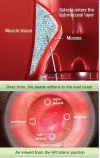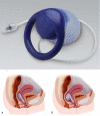Evidence-Based Update on Treatments of Fecal Incontinence in Women
- PMID: 26880511
- PMCID: PMC4758704
- DOI: 10.1016/j.ogc.2015.10.005
Evidence-Based Update on Treatments of Fecal Incontinence in Women
Abstract
Fecal incontinence is a highly prevalent and distressing condition that has a negative impact on quality of life. The etiology is often multifactorial, and the evaluation and treatment of this condition can be hindered by a lack of understanding of the mechanisms and currently available treatment options. This article reviews the evidence-based update for the management of fecal incontinence.
Keywords: Accidental bowel leakage; Anal incontinence; Anal sphincter; Defecatory disorders; Fecal incontinence; Surgical treatment; Treatment.
Copyright © 2016 Elsevier Inc. All rights reserved.
Figures






Similar articles
-
Accidental Bowel Leakage/Fecal Incontinence: Evidence-Based Management.Obstet Gynecol Clin North Am. 2021 Sep;48(3):467-485. doi: 10.1016/j.ogc.2021.05.003. Obstet Gynecol Clin North Am. 2021. PMID: 34416932 Review.
-
Fecal incontinence: an update on available techniques in diagnosis and treatment.Surg Technol Int. 2008;17:156-64. Surg Technol Int. 2008. PMID: 18802896 Review.
-
Evolving therapy for fecal incontinence.Dis Colon Rectum. 2007 Nov;50(11):1950-67. doi: 10.1007/s10350-007-9009-2. Dis Colon Rectum. 2007. PMID: 17874167 Review.
-
Bowel management for the treatment of pediatric fecal incontinence.Pediatr Surg Int. 2009 Dec;25(12):1027-42. doi: 10.1007/s00383-009-2502-z. Epub 2009 Oct 15. Pediatr Surg Int. 2009. PMID: 19830436 Free PMC article. Review.
-
Impact of fecal incontinence and its treatment on quality of life in women.Womens Health (Lond). 2015 Mar;11(2):225-38. doi: 10.2217/whe.14.66. Womens Health (Lond). 2015. PMID: 25776296 Free PMC article. Review.
Cited by
-
Structure-function relationship of the human external anal sphincter.Int Urogynecol J. 2018 May;29(5):673-678. doi: 10.1007/s00192-017-3404-6. Epub 2017 Jul 8. Int Urogynecol J. 2018. PMID: 28689239 Free PMC article.
-
A short- and long-term follow-up study of intersphincteric NASHA Dx implants for fecal incontinence.Tech Coloproctol. 2022 Oct;26(10):813-820. doi: 10.1007/s10151-022-02645-6. Epub 2022 Jun 26. Tech Coloproctol. 2022. PMID: 35752984 Free PMC article.
-
Obstetric anal sphincter injuries (OASIS): using transperineal ultrasound (TPUS) for detecting, visualizing and monitoring the healing process.BMC Womens Health. 2022 Aug 10;22(1):339. doi: 10.1186/s12905-022-01915-7. BMC Womens Health. 2022. PMID: 35948903 Free PMC article.
-
Kegel Exercises, Biofeedback, Electrostimulation, and Peripheral Neuromodulation Improve Clinical Symptoms of Fecal Incontinence and Affect Specific Physiological Targets: An Randomized Controlled Trial.J Neurogastroenterol Motil. 2021 Jan 30;27(1):108-118. doi: 10.5056/jnm20013. J Neurogastroenterol Motil. 2021. PMID: 33109777 Free PMC article.
-
Characteristics Associated With Clinically Important Treatment Responses in Women Undergoing Nonsurgical Therapy for Fecal Incontinence.Am J Gastroenterol. 2020 Jan;115(1):115-127. doi: 10.14309/ajg.0000000000000482. Am J Gastroenterol. 2020. PMID: 31895722 Free PMC article. Clinical Trial.
References
Publication types
MeSH terms
Substances
Grants and funding
LinkOut - more resources
Full Text Sources
Other Literature Sources

